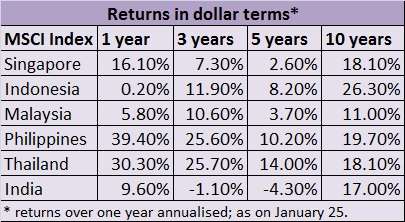Big money in small plates
Southeast Asian markets (ASEAN) seem to be the new destination for investors hungry for returns; so tells the performance of these markets in the last few years. The MSCI South East Asia Index delivered annualized returns of 13.1 per cent and 5.3 per cent in the last three and five years respectively. In comparison the BSE Sensex managed more mediocre numbers of 6.2 per cent and 1.8 per cent (would be slightly lower in dollar terms). In 2012 too, this index beat Indian markets.
The fund
It is perhaps spotting this potential, that in July 2011, JP Morgan asset Management launched a unique international fund that would go on to take exposure to markets in the Association of Southeast Asian nations (ASEAN). With a return of 24.6 per cent annually (in rupee terms) since its launch, JP Morgan JF ASEAN Equity Offshore emerged in the top five in the performance chart of Indian mutual funds over the same period.
Its one-year return at 31 per cent is way ahead of the equity fund category average of 13.6 per cent. Assets as of December 2012, was Rs 248 crore.
This fund uses the feeder route in invest in ASEAN markets. It invests 80-100 per cent of the Indian assets in units of parent fund, JP Morgan Fund – JF ASEAN Equity Fund. The parent fund was launched in 2009 and returned 21.2 per cent annually between then and December 2012 in dollar terms.
About ASEAN markets
Initially comprising of Singapore, Indonesia, Malaysia, Thailand and Philippines, more member nations such as Vietnam, Myanmar, Laos and Cambodia joined ASEAN. The ASEAN markets have in recent years been competing with larger emerging markets of China and India in terms of the stock returns they deliver.
How different are these markets from the China-India story? No doubt, ASEAN like its Indian and Chinese economies is a story of the rising middle class and higher investment spending. But these markets have in recent years differed from their big sisters on two accounts: one they have become more defensive in volatile times and have become more domestic-oriented. While not every member country may exude these characteristics, a good number do. Take the case of exports.
According to reports, export shipments of ASEAN countries to the US and European Union was less than a fifth of total exports in 2011 from as high as 72.4 per cent in 2000. The ASEAN nations themselves now account for over a fourth of exports. This has to some extent shielded these economies from the debt crisis of the developed Western regions. In contrast, China for instance has close to 40 per cent of its export revenue from The European Union and US.
Two, although these nations too, face the economic predicaments faced by India, they appear to be less worrying. For instance, Indonesia’s inflation, current account deficit and fiscal deficit are much lower than in India. While in Thailand, government spending has been muted thus far, private spending crossed the pre-Asian financial crisis levels. Contrast this to the almost lull in private spending by corporate in India in recent years. In other places like Philippines, services sector driven by BPO is on a sharp growth path.

Amidst these high growth economies is also a hedge by way of markets like Singapore. While not providing top returns, this market exposure can help stabilize returns during volatility.
ASEAN also offers opportunities in terms of large conglomerates of the nature that may not be available in the Indian markets. Industrial conglomerates like Keppel or consumer plays of Astra International’s scale are unlikely to be found in Indian markets for the present.
That said, the performance of the ASEAN markets cannot be entirely delinked from their peers in India and China. To this extent, investors cannot take exposure to these markets for hedging their portfolio. These markets at best act as diversifiers for a growth portfolio.
ASEAN focus
While there are quite a few Asia-focused funds, JP Morgan JF ASEAN Equity Offshore fund exclusively invests in ASEAN. It has been on a roll, thanks to the stock market performance in these regions.
While select regions such as Thailand and Philippines look expensive when compared with the Asia ex-Japan region, it is more to do with the underperformance of markets such as China. ASEAN markets are likely to remain destinations for return-hungry investors, in a way India is. Only, at this point, there seems less uncertainties surrounding the ASEAN compared with India.
Note:This is a review of the ASEAN markets and not a recommendation on the market or the JP Morgan JF ASEAN Equity Offshore fund. Investors should also note that international funds would receive capital gain tax treatment similar to debt funds.







